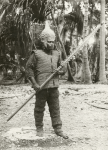Tack! Hade ingen aning om detta. Trodde namlukerna var egyptierUnder senmedeltiden var samma land också en framstående exportör av slavsoldater (mamluker) till Egypten, där de utgjorde en militär och även politisk elit. Den styrande sultandynastin från 1328 till 1517, då mamluksultanatet erövrades av ottomanska riket, var tjerkessisk.
You are using an out of date browser. It may not display this or other websites correctly.
You should upgrade or use an alternative browser.
You should upgrade or use an alternative browser.
Små historiska fakta som kan vara intressanta i rollspel
- Thread starter Genesis
- Start date
Tack för svar! Det var så jag lärde mig om detta. Skulle egentligen läsa om druzerna i området.Det finns en tjerkessisk diasporaminoritet i Israel. De har bott i området sedan den ottomanska tiden på 1800-talet.
Theo
Hero
- Joined
- 20 Nov 2017
- Messages
- 1,438
Tack! Hade ingen aning om detta. Trodde namlukerna var egyptier
Det beror på hur man räknar. De levde större delen av sina liv i Egypten och deras barn blev snabbt assimilerade, men mamlukkåren själv upprätthöll - artificiellt, frestas man säga - sin distinkta etniska särart, bl a genom att just t ex söner till mamluker inte fick bli mamluker utan de nyimporterades hela tiden utifrån. Så fungerade det f ö också med slavar i den muslimska världen i allmänhet: muslimer fick inte bli slavar så nya slavar måste hela tiden importeras från icke-muslimska länder, varpå de sedan vanligtvis konverterade till islam med följd att deras barn föddes som muslimer och därmed fria.
Tar man mamluker i bred bemärkelse som elit-slavsoldater i den muslimska världen i stort importerades de till att börja med främst från olika turkiska stäppfolk.
Mina efterforskningar om gammalt titelbruk ledde mig på en omväg till det fantastiska ordet "baggböleri" och de skandaler som myntade det:
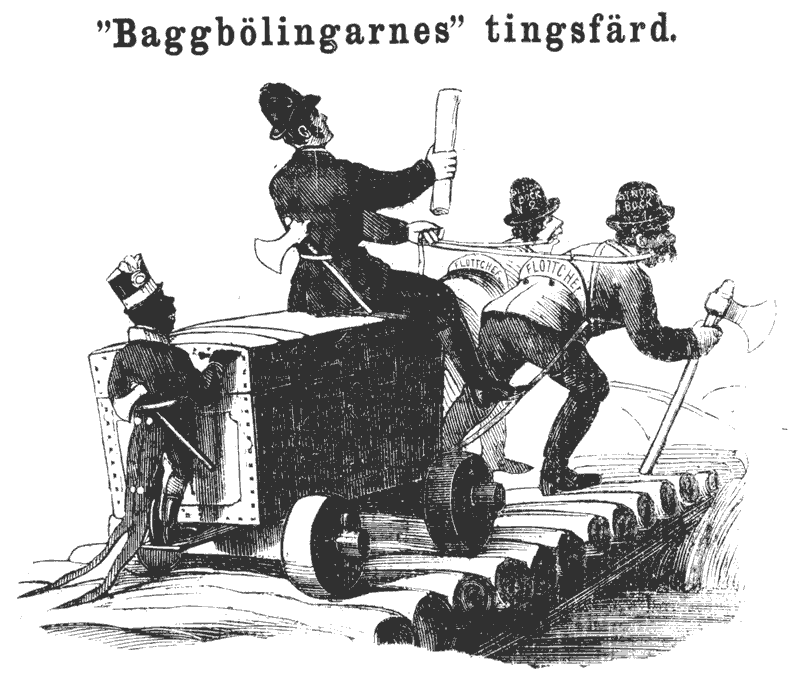
 sv.wikipedia.org
sv.wikipedia.org

Baggböleri – Wikipedia
Jag fortsätter att lite slött läsa på om det gamla bondesamhället, och hittar följade intressanta citat på Wikipedia-sidan för Barnamordsplakatet (!):
Det här känns som en fräck grej i ett drama där man inser vem som är ens riktiga mor, eller i ett mysteriespel där en rollperson bryter sig in på pastorsexpeditionen för att hitta det förseglade brevet som avslöjar någons egentliga härkomst.
(EDIT: Herregud vad tysklandskåta vi var på den tiden. "Sedan detta papper blifwigt med wederbörlig anteckning och prestens sigill försedt, bör qwinnan uppmanas att, för sin såwäl som barnets framtida säkerhet, samma papper noga förwara." Låter ju som ett dåligt julklappsrim där man sätter verbet sist för att få till rimmet.)
Lagen ändrades lite under 1800-talet. Enligt barnmorskereglementet år 1856 borde barnmorskan vid hemlig förlossning råda kvinnan att skriva ner sitt namn och hemort på ett förseglat papper. Det var sen upp till kvinnan att få prästen i den församling där födelsen skulle anmälas att sätta sitt sigill på papperet, och ordna säker förvaringsplats för det. Många av dessa papper förvarades i kyrkorna. Meningen med pappret och sigillet var att modern skulle kunna ångra det hon gjorde och återta sitt barn. De namnsedlar som förvarades på pastorsexpeditionerna kunde senare också öppnas på begäran av barnet.
Lagen från 1856 lyder så här:
"Hemtas Barnmorska till hemlig förlossning, eller mottager hon hos sig barnaföderska, som önskar vara okänd ware Barnmorska förbjudet att söka barnafaderns namn, eller qwinnan någon uppgift, som härmed kan ega sammanhang, aflocka eller aftwinga. Änskönt förlossningen warit hemlig, må dock Barnmorska hwarken sjelf undandölja barnet , eller till sådan åtgärd biträde lemna.--- Wid hemlig förlossning bör Barnmorskan för öfrigt råda qwinnan att uppteckna sitt namn och hemwist å ett papper, hwilket, af henne försegladt, förelägges den prest, för hwilken hon ofördröjligen skall förlossningen anmäla --- Sedan detta papper blifwigt med wederbörlig anteckning och prestens sigill försedt, bör qwinnan uppmanas att, för sin såwäl som barnets framtida säkerhet, samma papper noga förwara."
Plakatet gällde till 1917, då möjligheten till anonym barnfödsel försvann.
Det här känns som en fräck grej i ett drama där man inser vem som är ens riktiga mor, eller i ett mysteriespel där en rollperson bryter sig in på pastorsexpeditionen för att hitta det förseglade brevet som avslöjar någons egentliga härkomst.
(EDIT: Herregud vad tysklandskåta vi var på den tiden. "Sedan detta papper blifwigt med wederbörlig anteckning och prestens sigill försedt, bör qwinnan uppmanas att, för sin såwäl som barnets framtida säkerhet, samma papper noga förwara." Låter ju som ett dåligt julklappsrim där man sätter verbet sist för att få till rimmet.)
Last edited:
Mekanurg
Because if not I, who? If not now, when?
Herregud vad tysklandskåta vi var på den tiden. "Sedan detta papper blifwigt med wederbörlig anteckning och prestens sigill försedt, bör qwinnan uppmanas att, för sin såwäl som barnets framtida säkerhet, samma papper noga förwara." Låter ju som ett dåligt julklappsrim där man sätter verbet sist för att få till rimmet.)
Hursomhelst, under 1920-talet (tänk Call of Cthulhu Sverige) fungerade det så här istället för ogifta mödrar:
De obemärkta kvinnornas öde
Vart reste – förr i tiden – de gravida kvinnor som ville föda barn utan att någon skulle veta om det hemma? Den frågan har författarinnan och historikern Anita Maria Karlsson i Järnboås, norr om Nora, efter flera år av forskning försökt besvara i sin senaste bok, ”Obemärkta kvinnor – okända män”.
JohanL
Champion
- Joined
- 23 Jan 2021
- Messages
- 10,085
Inget litet historiskt fakta. Men jag lärde mig just att det fanns ett land vid östra Svarta Havet vid namn Cirkassien/Tjerkessien. De förlorade ett krig mot Ryssland under 1800talet varpå ett brutalt folkmord följde där majoriteten dog eller fördrevs. Folket lever vidare i diaspora. De var pga hotet mot dem ett militariskt folk och goda krigare. För den som vill skriva en mörk berättelse i stil med Monsegur så finns där nåt att hämta.
Kanske det första moderna folkmordet, skulle jag säga (annars brukar man ofta säga Herero-folkmordet).
Last edited:
Några historiska personer man kan krydda sin kampanj med (bild o text från Chris Schweizer — Black History Month! 2017 note ):
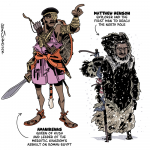
Amanirenas was the one-eyed queen of the Meroitic Kingdom of Kush. To forestall the Roman Empire’s push into Africa, she led Kushite forces in an attack on the Roman colonies in Egypt, defeating Rome’s forces and holding the colonies for a year, which began a five-year war with Rome that ended with a treaty stipulating that the Romans evacuate their capital and that the Kushites did not have to pay the Emperor tribute (they did agree to permit a Roman frontier border occupation in their lands). This began two centuries of peace between the Kingdom of Kush and the Roman Empire.
Matthew Henson was an explorer, the first man on record to reach the North Pole. Growing up a sailor, he became friends with Commander Peary while they were exploring the jungles of Nicaragua. The two joined forces for a series of arctic expeditions, during which time Peary became the only non-Inuit explorer to learn the language and knew how to train and drive sled dogs.
When he, four Inuits, and Peary made their final push to the North Pole, Peary was unable to continue (he was ill, worn out, and had bad frostbite), and Henson struck out on his own. Finding his way to the Pole, he planted the American flag, later returning for Peary and the Inuit sled team to escort them to the Pole (Peary was not able to get to it, being confined to the sled).
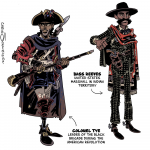
Colonel Tye escaped from slavery at age 21 during the American Revolution and joined the British, who promised slaves their freedom. Tye fought in the “Ethiopian Regiment,” a black unit, at the Battle of Monmouth. Quickly showcasing his skill for forage and guerrilla tactics, he was offered command of a group of 24 commandos, hand-picked from among the British’s black troops. Sometimes teaming up with the Queen’s Raiders (another guerrilla unit, this one white), they struck along the land from New York to Virginia, taking rebel prisoners, killing rebel military commanders, and capturing much needed food, fuel, and ammunition (contributing in no small part to New York’s survival during the siege of 1779), and freeing any slaves they encountered.
I made a comic story with Tye in it called “The Black Brigade.” It can be found in the comic textbook “Reading with Pictures,” and in Oni Press’s Free Comic Book Day offering from 2013. I’ll try and post it up soon, I’ve been meaning to do so!
Bass Reeves was one of the most prolific and respected lawmen of the wild west. Born a slave, he escaped as a young man into Indian Territory during the Civil War, where he learned to speak a number of Native American languages, living amongst the Seminoles, Creeks, and Cherokee.
After the Civil War, his knowledge of Indian country landed him a position as a deputy US Marshall, working for Judge Parker. If you have read “True Grit” (the finest American novel ever written, I genuinely believe), or seen the film, Reeves basically had Rooster Cogburn’s job: riding out into lawless country to bring back dangerous fugitives (and for the same court).
A crack shot, ace detective, and master of disguise, Reeves successfully apprehended more than three THOUSAND fugitives, many of them notorious outlaws, gun killers, and murderers. He never received an injury, though over the course of his career he was in fourteen shootouts in which he killed fourteen men, all of whom drew first (Reeves would not draw his gun unless he felt he had to use it, feeling that it would increase the likelihood of a violent outcome).
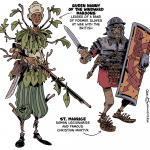
Queen Nanny was the leader of the Windward Maroons, a community of escaped slaves in the Caribbean in the early 1700s who were at war with the British. Heavily outnumbered, Nanny built her capitol on a high mountain in Jamaica (from whence we get Blue Mountain coffee), and they were able to defend their towns against attacks from British soldiers on numerous occasions, and built a series of politically connected villages under the protection of a central government built on the Ashanti tribal model. They grew crops, raised livestock, and traded with other islands. They would make regular attacks against towns and plantations to free the slaves there.
An excellent strategist, her troops became gifted in jungle disguise (which Nanny created from branches and leaves to serve as both camouflage and close-quarters armor) and often succeeded in ambushing the British troops when they would attempt an attack.
She reined for three decades, and freed more than eight hundred slaves, and in 1739 signed a peace treaty with the British which permitted the Maroons to keep their five towns and conditioned that they would fight alongside the British should they be attacked by foreign armies.
St. Maurice was a Roman Legionnaire and the leader of the sixty-six hundred soldiers that made up Theban Legion. According to legend (which, like much in religious history, probably has some historical root but which has been distorted over the years to where it no longer jives directly with what we know of the time period and the politics at play), the Legion converted en masse to Christianity and was decimated (every tenth soldier killed) for refusing to obey orders (specifically, that they offer sacrifices to pagan gods on their route to Gaul). Maurice was a very popular saint until the mid-1500s, when the African slave trade started up and Europeans started to feel like real jerks for asking the intercession of one African while denying the humanity of others, so they stopped using him as a central feature in art and architecture.Though there is no historical evidence for Maurice from his lifetime, he is a good avenue through which to look at black Roman soldiers in the 3rd century, which one rarely sees in films. Some of the most important Roman military finds were in York, England (where I was lucky to live for a while as a young man), where large burial grounds of soldiers have been unearthed over the past half-century. The soldiers buried at York were part of the group stationed near Hadrian’s Wall, which separated “civilized” Rome from the wild barbarians of the north. Seen Game of Thrones? These guys were the Night’s Watch.
Forensic anthropology from multiple sites there has shown that the soldiers buried were roughly 60% white, 13% North African, and 25% sub-Saharan African, so black soldiers were more not an unusual novelty in the 3rd century Roman army, they were about a quarter of it (Rome of course “recruited” from the populations of any areas that the Empire conquered).
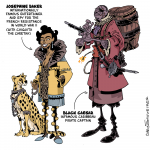
Josephine Baker was a world-famous entertainer and the first black woman to star in a major motion picture. She was also a spy for the French Resistance when France was occupied by the Nazis during WWII.A renowned dancer on Broadway, she was known for her hilarious comic timing and technical proficiency. On moving to France, she became a popular (and controversial, due to the erotic-tinged nature of her dances) performer.During WWII, she used her clout to find visas for resitance fighters and refugees, and used her show travels as an excuse for espionage. She would perform mostly in heavily-occupied or strategically important places, gathering information for the resistance and transporting it pinned inside her underwear, banking on her fame and reputation to keep her from being strip-searched at checkpoints. She refused to perform in front of segregated audiences, wouldn’t take racist bunk from anybody. She was actively involved in the Civil Rights movement in the US, and after Martin Luther King’s assassination, she was asked by Coretta Scott King and others in the movement to take his place as its leader. She labored over the decision for more than a week, and declined. She had adopted twelve children and did not want to risk their lives or leave them without a mother, something that the murders (some of them house bombings) of other civil rights leaders at the time portended. For her service to Free France, Baker was awarded the Croix de guerre and was made a Knight of the Legion of Honor.I drew her with her pet cheetah, Chiquita, who would sometimes get bored with Baker’s act and jump into the orchestra pit, sending the musicians scurrying.
Black Caesar was a pirate who scourged the Caribbean shipping lanes off the Florida Keys for ten years.A chief in West Africa, he was captured when a ship with which his village was trading cast off with him aboard, the crew intending to sell him into slavery. When the ship hit a hurricane, he and a crewman with whom he’d become friends took the ship’s provision and survived by taking a longboat to shore as the ship was destroyed. He and the other man used the longboat to begin a pirating enterprise that continued for years, grew larger, and amassed each considerable treasure, until the two fought a duel over a woman which Caesar one. He amassed a crew and created a kind of Batcave-like hideout in Biscayne Bay that included a system of elaborate pulleys that would serve as elevators, trap doors, and ship-hiders (tipping the ships over on their side to hide their masts from the view of Naval patrols).
He eventually teamed up with Blackbeard, and was one of the last men in the crew of the Queen Anne’s Revenge still fighting after Blackbeard died (reportedly from more than twenty sword wounds and five gunshots). When it was seen that he would not escape the battle alive, Caesar attempted to blow up the ship’s gunpowder but was eventually subdued by the combined might of the Navy’s sailors. He was convicted of piracy and executed.
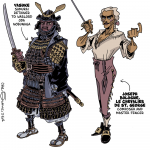
Yasuke was the first non-Japanese person to become a Samurai. He arrived in Japan in 1579, a tall young man from Mozambique working as a servant for Jesuit Missionaries. His appearance caused a sensation to the isolated Japanese, and by 1581 word of his presence reached ears of Oda Nobunaga, one of the most powerful warlords in the country. Nobunaga met Yasuke (insisting that his chest be scrubbed to make sure that his dark skin wasn’t a trick), and was impressed by his size, strength, and grasp of the language, and brought him into his service. Over the next year, Yasake received martial training and was made a samurai.
Nobunaga was killed by the army of a rival the following year, and Yasuke went to protect Nobunaga’s heir. He and the heir fought for some time when ambushed between castles, but were beaten. The heir was forced to commit seppuku, and Yasuke was sent to Kyoto, where he disappears from the records.
Joseph Bologne, Le Chevalier de Saint George was the colonel commanding the first black regiment in Europe, the Legion de Saint-Georges, fighting for the French Republic before Napoleon staged his coup.
As a teenager, he became widely known as one of the best swordsmen in Europe, his celebrity rising when he besting a champion fencing master at 17 in a very public duel. He was also considered to be one of the best-looking men in Paris, a fine wit, and an exceptional dancer. In his mid-twenties he became a renowned violinist and began performing his own compositions (which you can easily find), before turning his attention to opera. Here’s a link to a long grouping of some of his violin concertos:
https://www.youtube.com/watch?v=yN9_weY_Hls
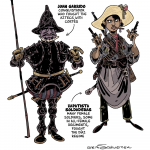
Juan Garrido was a Spanish Conquistador, part of the small group of combatants responsible for the European victory over the Aztecs and the conquering of Mexico. There were quite a few African freemen on the expedition, but Garrido was the highest African-born soldier in rank. Among his non-military accomplishments were the building of a chapel in honor of the Spanish dead, the cultivation of wheat in the Americas, and “discovering” (mapping) nearby islands.
Zapatista Soldadera The Mexican Revolution, which sprang up in response to the corrupt dictatorship of Porfirio Diaz, had any number of Revolutionary factions, and while some leaders (like Pancho Villa) disdained the use of women soldiers (though Villa himself had a few whose skills made it worth discounting his gender principles for their service), Emiliano Zapata had a substantial number of female combatants in his army. A number of these women were Afro-Mexicans, probably descendants of the estimated four thousand former slaves who escaped to anti-slavery Mexico between 1829 and 1865 or the black migrants in the 1890s. Most of the names of the roughly two hundred fighting soldaderas are lost to time, and with the exception of two (a Dutch-Mexican woman and an Afro-Mexican transgender man) I could not find any reputable citations linking the specific women of note with the many anonymous photos of the soldaderas (Euro, Indigenous, and Afro), so I’m not sure who was black and who wasn’t, hence the composite character.
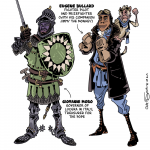
Giovanni Moro was a knight, the commander of the castle in Lucera, Italy, where he was the governor, which had a large Moorish immigrant population. Giovanni was the treasurer of the kingdom of Sicily and a considerable landholder. When the Pope attempted to have Manfred (the future king of Sicily, a famous knight who had often championed the rights of the immigrant Moors) assassinated, he came to Giovanni for aid. Giovanni and his soldiers joined Manfred in 1253 to fight against the army of Rome, winning a number of victories. Giovanni ended up being killed amidst everyone’s nonstop political intrigues, including his own (like Manfred, he was making secret secret negotiations with the Pope; unlike Manfred, he was killed by some of his own soldiers).
Eugene Bullard was an American who went to Europe at a young age, became a prizefighter, joined the French Foreign Legion, was seriously wounded in the Battle of Verdun, volunteered to join the newly created French Air Service, joined the Lafayette Flying Corps (American pilots who fought with France, since America hadn’t entered the war), and was promoted to Corporal. When America entered the war, the United States Army Air Service invited him to join based on his record, but when they discovered that he was black they rescinded the invitation, because America, at the time, sucked. He continued to fight with France.
He later married the daughter of a Countess, owned a fashionable nightclub, became friends with Louis Armstrong and Ernest Hemingway, was a spy against the Nazis in the lead-up to WWII, and fought defending Orleans from the invading German army. He was injured, and when Orleans fell, he escaped to Spain, and then to New York. Among the fifteen medals he received, he was made a Knight of the Legion of Honor, France’s highest military honor. Oh, and he always took to the skies with his faithful companion Jimmy the Rhesus Monkey.

Amanirenas was the one-eyed queen of the Meroitic Kingdom of Kush. To forestall the Roman Empire’s push into Africa, she led Kushite forces in an attack on the Roman colonies in Egypt, defeating Rome’s forces and holding the colonies for a year, which began a five-year war with Rome that ended with a treaty stipulating that the Romans evacuate their capital and that the Kushites did not have to pay the Emperor tribute (they did agree to permit a Roman frontier border occupation in their lands). This began two centuries of peace between the Kingdom of Kush and the Roman Empire.
Matthew Henson was an explorer, the first man on record to reach the North Pole. Growing up a sailor, he became friends with Commander Peary while they were exploring the jungles of Nicaragua. The two joined forces for a series of arctic expeditions, during which time Peary became the only non-Inuit explorer to learn the language and knew how to train and drive sled dogs.
When he, four Inuits, and Peary made their final push to the North Pole, Peary was unable to continue (he was ill, worn out, and had bad frostbite), and Henson struck out on his own. Finding his way to the Pole, he planted the American flag, later returning for Peary and the Inuit sled team to escort them to the Pole (Peary was not able to get to it, being confined to the sled).

Colonel Tye escaped from slavery at age 21 during the American Revolution and joined the British, who promised slaves their freedom. Tye fought in the “Ethiopian Regiment,” a black unit, at the Battle of Monmouth. Quickly showcasing his skill for forage and guerrilla tactics, he was offered command of a group of 24 commandos, hand-picked from among the British’s black troops. Sometimes teaming up with the Queen’s Raiders (another guerrilla unit, this one white), they struck along the land from New York to Virginia, taking rebel prisoners, killing rebel military commanders, and capturing much needed food, fuel, and ammunition (contributing in no small part to New York’s survival during the siege of 1779), and freeing any slaves they encountered.
I made a comic story with Tye in it called “The Black Brigade.” It can be found in the comic textbook “Reading with Pictures,” and in Oni Press’s Free Comic Book Day offering from 2013. I’ll try and post it up soon, I’ve been meaning to do so!
Bass Reeves was one of the most prolific and respected lawmen of the wild west. Born a slave, he escaped as a young man into Indian Territory during the Civil War, where he learned to speak a number of Native American languages, living amongst the Seminoles, Creeks, and Cherokee.
After the Civil War, his knowledge of Indian country landed him a position as a deputy US Marshall, working for Judge Parker. If you have read “True Grit” (the finest American novel ever written, I genuinely believe), or seen the film, Reeves basically had Rooster Cogburn’s job: riding out into lawless country to bring back dangerous fugitives (and for the same court).
A crack shot, ace detective, and master of disguise, Reeves successfully apprehended more than three THOUSAND fugitives, many of them notorious outlaws, gun killers, and murderers. He never received an injury, though over the course of his career he was in fourteen shootouts in which he killed fourteen men, all of whom drew first (Reeves would not draw his gun unless he felt he had to use it, feeling that it would increase the likelihood of a violent outcome).

Queen Nanny was the leader of the Windward Maroons, a community of escaped slaves in the Caribbean in the early 1700s who were at war with the British. Heavily outnumbered, Nanny built her capitol on a high mountain in Jamaica (from whence we get Blue Mountain coffee), and they were able to defend their towns against attacks from British soldiers on numerous occasions, and built a series of politically connected villages under the protection of a central government built on the Ashanti tribal model. They grew crops, raised livestock, and traded with other islands. They would make regular attacks against towns and plantations to free the slaves there.
An excellent strategist, her troops became gifted in jungle disguise (which Nanny created from branches and leaves to serve as both camouflage and close-quarters armor) and often succeeded in ambushing the British troops when they would attempt an attack.
She reined for three decades, and freed more than eight hundred slaves, and in 1739 signed a peace treaty with the British which permitted the Maroons to keep their five towns and conditioned that they would fight alongside the British should they be attacked by foreign armies.
St. Maurice was a Roman Legionnaire and the leader of the sixty-six hundred soldiers that made up Theban Legion. According to legend (which, like much in religious history, probably has some historical root but which has been distorted over the years to where it no longer jives directly with what we know of the time period and the politics at play), the Legion converted en masse to Christianity and was decimated (every tenth soldier killed) for refusing to obey orders (specifically, that they offer sacrifices to pagan gods on their route to Gaul). Maurice was a very popular saint until the mid-1500s, when the African slave trade started up and Europeans started to feel like real jerks for asking the intercession of one African while denying the humanity of others, so they stopped using him as a central feature in art and architecture.Though there is no historical evidence for Maurice from his lifetime, he is a good avenue through which to look at black Roman soldiers in the 3rd century, which one rarely sees in films. Some of the most important Roman military finds were in York, England (where I was lucky to live for a while as a young man), where large burial grounds of soldiers have been unearthed over the past half-century. The soldiers buried at York were part of the group stationed near Hadrian’s Wall, which separated “civilized” Rome from the wild barbarians of the north. Seen Game of Thrones? These guys were the Night’s Watch.
Forensic anthropology from multiple sites there has shown that the soldiers buried were roughly 60% white, 13% North African, and 25% sub-Saharan African, so black soldiers were more not an unusual novelty in the 3rd century Roman army, they were about a quarter of it (Rome of course “recruited” from the populations of any areas that the Empire conquered).

Josephine Baker was a world-famous entertainer and the first black woman to star in a major motion picture. She was also a spy for the French Resistance when France was occupied by the Nazis during WWII.A renowned dancer on Broadway, she was known for her hilarious comic timing and technical proficiency. On moving to France, she became a popular (and controversial, due to the erotic-tinged nature of her dances) performer.During WWII, she used her clout to find visas for resitance fighters and refugees, and used her show travels as an excuse for espionage. She would perform mostly in heavily-occupied or strategically important places, gathering information for the resistance and transporting it pinned inside her underwear, banking on her fame and reputation to keep her from being strip-searched at checkpoints. She refused to perform in front of segregated audiences, wouldn’t take racist bunk from anybody. She was actively involved in the Civil Rights movement in the US, and after Martin Luther King’s assassination, she was asked by Coretta Scott King and others in the movement to take his place as its leader. She labored over the decision for more than a week, and declined. She had adopted twelve children and did not want to risk their lives or leave them without a mother, something that the murders (some of them house bombings) of other civil rights leaders at the time portended. For her service to Free France, Baker was awarded the Croix de guerre and was made a Knight of the Legion of Honor.I drew her with her pet cheetah, Chiquita, who would sometimes get bored with Baker’s act and jump into the orchestra pit, sending the musicians scurrying.
Black Caesar was a pirate who scourged the Caribbean shipping lanes off the Florida Keys for ten years.A chief in West Africa, he was captured when a ship with which his village was trading cast off with him aboard, the crew intending to sell him into slavery. When the ship hit a hurricane, he and a crewman with whom he’d become friends took the ship’s provision and survived by taking a longboat to shore as the ship was destroyed. He and the other man used the longboat to begin a pirating enterprise that continued for years, grew larger, and amassed each considerable treasure, until the two fought a duel over a woman which Caesar one. He amassed a crew and created a kind of Batcave-like hideout in Biscayne Bay that included a system of elaborate pulleys that would serve as elevators, trap doors, and ship-hiders (tipping the ships over on their side to hide their masts from the view of Naval patrols).
He eventually teamed up with Blackbeard, and was one of the last men in the crew of the Queen Anne’s Revenge still fighting after Blackbeard died (reportedly from more than twenty sword wounds and five gunshots). When it was seen that he would not escape the battle alive, Caesar attempted to blow up the ship’s gunpowder but was eventually subdued by the combined might of the Navy’s sailors. He was convicted of piracy and executed.

Yasuke was the first non-Japanese person to become a Samurai. He arrived in Japan in 1579, a tall young man from Mozambique working as a servant for Jesuit Missionaries. His appearance caused a sensation to the isolated Japanese, and by 1581 word of his presence reached ears of Oda Nobunaga, one of the most powerful warlords in the country. Nobunaga met Yasuke (insisting that his chest be scrubbed to make sure that his dark skin wasn’t a trick), and was impressed by his size, strength, and grasp of the language, and brought him into his service. Over the next year, Yasake received martial training and was made a samurai.
Nobunaga was killed by the army of a rival the following year, and Yasuke went to protect Nobunaga’s heir. He and the heir fought for some time when ambushed between castles, but were beaten. The heir was forced to commit seppuku, and Yasuke was sent to Kyoto, where he disappears from the records.
Joseph Bologne, Le Chevalier de Saint George was the colonel commanding the first black regiment in Europe, the Legion de Saint-Georges, fighting for the French Republic before Napoleon staged his coup.
As a teenager, he became widely known as one of the best swordsmen in Europe, his celebrity rising when he besting a champion fencing master at 17 in a very public duel. He was also considered to be one of the best-looking men in Paris, a fine wit, and an exceptional dancer. In his mid-twenties he became a renowned violinist and began performing his own compositions (which you can easily find), before turning his attention to opera. Here’s a link to a long grouping of some of his violin concertos:
https://www.youtube.com/watch?v=yN9_weY_Hls

Juan Garrido was a Spanish Conquistador, part of the small group of combatants responsible for the European victory over the Aztecs and the conquering of Mexico. There were quite a few African freemen on the expedition, but Garrido was the highest African-born soldier in rank. Among his non-military accomplishments were the building of a chapel in honor of the Spanish dead, the cultivation of wheat in the Americas, and “discovering” (mapping) nearby islands.
Zapatista Soldadera The Mexican Revolution, which sprang up in response to the corrupt dictatorship of Porfirio Diaz, had any number of Revolutionary factions, and while some leaders (like Pancho Villa) disdained the use of women soldiers (though Villa himself had a few whose skills made it worth discounting his gender principles for their service), Emiliano Zapata had a substantial number of female combatants in his army. A number of these women were Afro-Mexicans, probably descendants of the estimated four thousand former slaves who escaped to anti-slavery Mexico between 1829 and 1865 or the black migrants in the 1890s. Most of the names of the roughly two hundred fighting soldaderas are lost to time, and with the exception of two (a Dutch-Mexican woman and an Afro-Mexican transgender man) I could not find any reputable citations linking the specific women of note with the many anonymous photos of the soldaderas (Euro, Indigenous, and Afro), so I’m not sure who was black and who wasn’t, hence the composite character.

Giovanni Moro was a knight, the commander of the castle in Lucera, Italy, where he was the governor, which had a large Moorish immigrant population. Giovanni was the treasurer of the kingdom of Sicily and a considerable landholder. When the Pope attempted to have Manfred (the future king of Sicily, a famous knight who had often championed the rights of the immigrant Moors) assassinated, he came to Giovanni for aid. Giovanni and his soldiers joined Manfred in 1253 to fight against the army of Rome, winning a number of victories. Giovanni ended up being killed amidst everyone’s nonstop political intrigues, including his own (like Manfred, he was making secret secret negotiations with the Pope; unlike Manfred, he was killed by some of his own soldiers).
Eugene Bullard was an American who went to Europe at a young age, became a prizefighter, joined the French Foreign Legion, was seriously wounded in the Battle of Verdun, volunteered to join the newly created French Air Service, joined the Lafayette Flying Corps (American pilots who fought with France, since America hadn’t entered the war), and was promoted to Corporal. When America entered the war, the United States Army Air Service invited him to join based on his record, but when they discovered that he was black they rescinded the invitation, because America, at the time, sucked. He continued to fight with France.
He later married the daughter of a Countess, owned a fashionable nightclub, became friends with Louis Armstrong and Ernest Hemingway, was a spy against the Nazis in the lead-up to WWII, and fought defending Orleans from the invading German army. He was injured, and when Orleans fell, he escaped to Spain, and then to New York. Among the fifteen medals he received, he was made a Knight of the Legion of Honor, France’s highest military honor. Oh, and he always took to the skies with his faithful companion Jimmy the Rhesus Monkey.
JohanL
Champion
- Joined
- 23 Jan 2021
- Messages
- 10,085
(EDIT: Herregud vad tysklandskåta vi var på den tiden. "Sedan detta papper blifwigt med wederbörlig anteckning och prestens sigill försedt, bör qwinnan uppmanas att, för sin såwäl som barnets framtida säkerhet, samma papper noga förwara." Låter ju som ett dåligt julklappsrim där man sätter verbet sist för att få till rimmet.)
Gammal klassiker: "Om dig, Andersson, har jag, då du, då jag, till följd av iråkad snuva, råkade nysa, brast i skratt, fått en mycket ofördelaktig uppfattning."
Gelékub
Gelékub
- Joined
- 8 Mar 2021
- Messages
- 1,741
Älskar, älskar historien om kadaver-synoden och det efterföljande ödet som drabbade påve Stephanus IV. Känns helt rätt för en mysig grym-mörk setting.
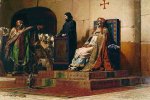

Rymdhamster
ɹǝʇsɯɐɥpɯʎɹ
Enligt den här youtubefilmen var "spettpojke" i medeltida kök inget trevligt arbete. Förutom röken kunde dessa få huden bortbränd på den sida som var vänd mot elden, och det var tydligen en ynnest om kökschefen lät en byta sida nån gång ibland. Jag antar att djuret som grillades ofta var värt mer än ett barn...
Ingen aning om det är sant. Men det låter som en ypperlig detalj om man vill lyfta fram hur omänsklig en härskare är mot sina undersåtar.
Ingen aning om det är sant. Men det låter som en ypperlig detalj om man vill lyfta fram hur omänsklig en härskare är mot sina undersåtar.
JohanL
Champion
- Joined
- 23 Jan 2021
- Messages
- 10,085
Enligt den här youtubefilmen var "spettpojke" i medeltida kök inget trevligt arbete. Förutom röken kunde dessa få huden bortbränd på den sida som var vänd mot elden, och det var tydligen en ynnest om kökschefen lät en byta sida nån gång ibland. Jag antar att djuret som grillades ofta var värt mer än ett barn...
Ingen aning om det är sant. Men det låter som en ypperlig detalj om man vill lyfta fram hur omänsklig en härskare är mot sina undersåtar.
Jämför:

Turnspit dog - Wikipedia
Kinesiska studiekommissionen på besök i L.M. Ericssons minnesrum på Thulegatan, Stockholm, 26 april 1906.
![[IMG] [IMG]](https://www.ericsson.com/4a80a7/assets/global/qbank/2017/09/29/sweden-1906-chinese-delegation-visits-lme_2_with-old-logo-3.jpg?w=1410)
Kinesiska studiekommissionen - Tekniska museet / DigitaltMuseum
![[IMG] [IMG]](https://www.ericsson.com/4a80a7/assets/global/qbank/2017/09/29/sweden-1906-chinese-delegation-visits-lme_2_with-old-logo-3.jpg?w=1410)
Kinesiska studiekommissionen - Tekniska museet / DigitaltMuseum
Jag lärde mig om "decklade" sidor i tråden WFRP 4th - Imperial Zoo, men historien kring tekniken är väl värd att lägga in i t.ex. ett CoC-äventyr när de hittar en gammal bok. Utöver Wikipedia-artikeln ger Bookriot lite bakgrund: den ojämna kanten var till en början en effekt av tekniken för papperstillverkning och sågs som en defekt. Bokbindarna skar därför bort denna men över århundradena svängde svängde smaken hos boksamlarna ("boknördarna") och en ojämn kant blev ett tecken på kvalité och främst på handgjort papper (till skillnad ifrån maskingjort och framförallt när maskinerna gjorde pappret på rulle istället för blad för blad). En bok men jämn kant kunde vara ett tecken på att boken bundits om, ett tecken på att det inte var en originalutgåva trots allt. Bokbindarna skapade på verktyg och maskiner för att fila upp den skurna kanten för att ge intryck av ett handgjort papper.
Nu kommer den viktiga frågan: hur göra det här till en viktig ledtråd i ett boksökaräventyr...?
Nu kommer den viktiga frågan: hur göra det här till en viktig ledtråd i ett boksökaräventyr...?
kanske något i den här stilen?Nu kommer den viktiga frågan: hur göra det här till en viktig ledtråd i ett boksökaräventyr...?
Speciellt om man kombinerar med näst sista scenen i filmen...
Brilliant, särskilt som jag baserade delar av en Over the Edge-kampanj på just den filmen...kanske något i den här stilen?
Speciellt om man kombinerar med näst sista scenen i filmen...
JohanL
Champion
- Joined
- 23 Jan 2021
- Messages
- 10,085
Rymdhamster
ɹǝʇsɯɐɥpɯʎɹ
En valaska, eller "herdeyxa" var en lättare yxa med långt skaft som kunde användas som vandringskäpp, och var vanligt bland östeuropeiska herdar både som verktyg och vapen. Jag fann den både estetiskt tilltalande och intressant ur rollspelsvapensynpunkt. Jag ser framför mig hur en grupp getherdar skulle kunna vara ett formidabelt mostånd, dels med tanke på herdar med yxor, dels med tanke på arga getter.



